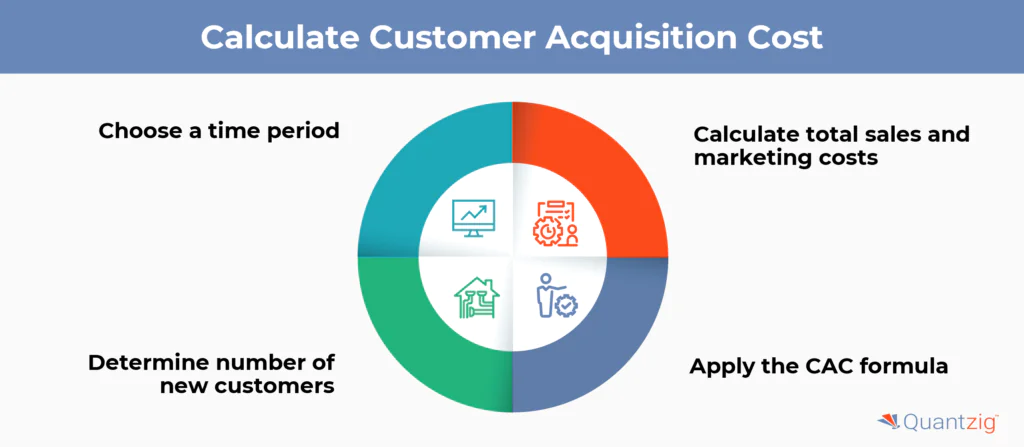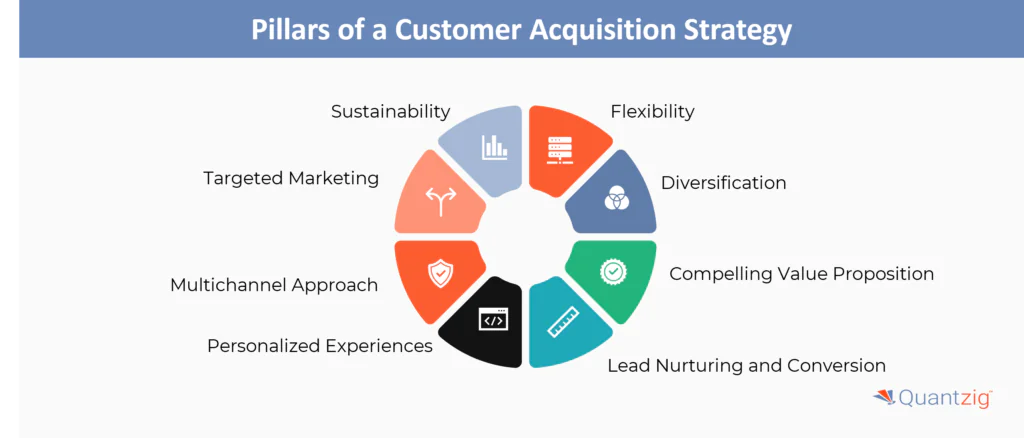Table of Contents
Table of Contents
- Introduction
- What Is Customer Acquisition?
- Importance of Customer Acquisition
- Purpose of Customer Acquisition
- Calculate & Minimize Customer Acquisition Cost
- Customer Acquisition Funnel
- Customer Acquisition Channels
- Pillars of a Robust Customer Acquisition Strategy
- Customer Acquisition Strategy Examples
- Conclusion
Author: Associate Vice President, Analytics and Data Strategy, Quantzig.
Introduction to Customer Acquisition Strategy
A well-designed customer acquisition strategy can help organizations attract, convert, and retain high-value customers in a cost-efficient manner. However, building a robust customer acquisition strategy requires a deep understanding of key pillars that underpin its success. The foundation of an effective customer acquisition strategy rests on several critical pillars, including sustainability, flexibility, targeted marketing, and diversification. By addressing these pillars, businesses can develop a comprehensive approach that not only attracts new customers but also fosters long-term loyalty and advocacy.
In this article, we will delve into the key pillars of a robust customer acquisition strategy, exploring how organizations can leverage these principles to gain a competitive edge and achieve their revenue goals.
Book a demo to experience the meaningful insights we derive from data through our analytical tools and platform capabilities. Schedule a demo today!
Request a Free DemoWhat Is Customer Acquisition?
Customer acquisition is a process to bring new customers down the marketing funnel from brand awareness to purchase decisions. It encompasses the entire journey of a buyer, from the time they become a lead until they become a loyal customer. Businesses need to track and measure their customer acquisition efforts to stay ahead of their competitors.
Businesses can do so by using metrics such as conversion rate, customer acquisition rate, rate of new customer acquisition, and rate of visits to specific product pages. Keeping track of customer acquisition efforts can further help companies to understand the customer’s journey and identify how different touchpoints are impacting the customer’s purchase behavior. As a result, businesses can determine and capitalize on the right opportunities to improve profitability.
Why is Customer Acquisition Process Important?
Customer acquisition is a critical component of business growth and sustainability. Attracting new customers not only expands your customer base but also provides opportunities to generate revenue, increase market share, and drive long-term profitability. Effective customer acquisition strategies enable businesses to replace lost customers, diversify their customer portfolio, and explore new market segments, ultimately strengthening their competitive position and ensuring the continued success of the organization.
What is the Purpose of Customer Acquisition Process?
The purpose of customer acquisition is to attract and convert potential customers into paying customers for a business’s products or services. It involves various marketing and sales strategies aimed at understanding customer needs, creating targeted messages or offers, and guiding individuals through the sales funnel to ultimately make a purchase or commit to a service.
How to Calculate & Minimize Customer Acquisition Cost?

Here are the key steps to calculate and minimize customer acquisition cost (CAC):
Calculating CAC
- Choose a time period: Select a time frame for your CAC calculation, such as a month, quarter or year.
- Calculate total sales and marketing costs: Add up all expenses related to acquiring new customers, including:
- Ad spend
- Salaries for sales and marketing teams
- Software and tools
- Content creation and publishing costs
- Promotional offers and discounts
- Determine number of new customers: Count the total number of new customers acquired during the chosen time period.
- Apply the CAC formula:
CAC = (Total sales and marketing costs) / (Number of new customers)
For example, if you spent $800,000 on sales and marketing to acquire 1,000 new customers, your CAC would be:
CAC = $800,000 / 1,000 = $800 per customer
Minimizing CAC
- Optimize your sales and marketing funnel: Analyze each step of the customer journey to identify areas for improvement. Use the Balfour Method to ensure proper mechanics in your acquisition channels.
- Optimize pricing strategy: Implement value-based pricing with upfront costs to recover CAC faster. Aim to spend 33% or less of customer lifetime value (LTV) on CAC.
- Improve sales and marketing effectiveness: Focus spending on high-value channels that drive the most valuable customers. Track key metrics like cost per lead and customer to optimize performance.
- Engage new customers quickly: Reduce time to first product engagement to lower CAC. The faster customers start using your product, the more cost-effective acquisition becomes.
- Leverage re-engagement emails: Target prospects who didn’t convert initially with cart abandonment emails and other re-engagement campaigns to boost conversion rates.
- Provide self-service resources: Create FAQs, help guides and a knowledge base to reduce reliance on costly sales and support interactions.
- Personalize website content: Tailor messaging and offers to individual users based on their needs and behaviors to improve conversion rates.
By following these strategies to calculate and optimize your CAC, you can acquire customers more cost-effectively and drive sustainable growth for your business.
Customer Acquisition Funnel
| Customer Acquisition Funnel | Description |
|---|---|
| Awareness | This is the top of the funnel, where potential customers first become aware of your product or service. This can happen through various marketing channels like advertising, content marketing, social media, etc. |
| Interest | At this stage, the potential customer has shown interest in your offering and is researching more about it. They may be reading your website, engaging with your content, or comparing you to competitors. |
| Consideration | The potential customer is now evaluating whether your product or service is the right fit for their needs. They may be requesting demos, free trials, or consulting with your sales team. |
| Intent | The customer has decided they want to make a purchase and is ready to take action. They may be adding items to their cart or requesting a quote. |
| Conversion | This is the bottom of the funnel, where the potential customer completes the purchase and becomes a paying customer. |
| Retention | After the initial purchase, the focus shifts to retaining the customer and encouraging repeat business or referrals. |
Customer Acquisition Channels
Customer Acquisition Channels | Description |
|---|---|
| Organic Search | Optimizing your website and content for search engines to drive traffic from people actively searching for your products or services. |
| Paid Advertising | Running ads on platforms like Google, Facebook, LinkedIn, etc. to reach new potential customers. |
| Content Marketing | Creating valuable, informative content (blog posts, videos, webinars, etc.) to attract and engage potential customers. |
| Social Media | Leveraging social media platforms to build brand awareness, engage with potential customers, and drive traffic to your website. |
| Email Marketing | Building an email list and nurturing leads through personalized, targeted email campaigns. |
| Referral Programs | Incentivizing existing customers to refer new customers to your business. |
| Partnerships and Collaborations | Forming strategic partnerships with complementary businesses to cross-promote and access each other’s customer bases. |
| Events and Tradeshows | Participating in industry events, conferences, and tradeshows to connect with potential customers face-to-face. |
By understanding the customer acquisition funnel and the various channels available, businesses can develop a comprehensive strategy to attract, convert, and retain customers effectively.
Also Read: Track Business Progress with Marketing Analytics Dashboard
Experience the advantages firsthand by testing a customized complimentary pilot designed to address your specific requirements. Pilot studies are non-committal in nature.
Request a Free PilotWhat are the Key Pillars of a Robust Customer Acquisition Strategy?

Pillar #1: Sustainability
- Sustainability is very important for an acquisition strategy to be effective. A sustainable customer acquisition strategy can help establish your thought-leadership.
- Also, it can help businesses to succeed in the long-run and have an edge over their competitors.
Pillar #2: Flexibility
- Today’s customers are digitally empowered and that is why their response to any brand changes frequently. Therefore, the acquisition strategy should be flexible to respond to market trends effectively and efficiently.
- Also, a flexible customer acquisition strategy can help in offering better customer experience, improving brand image, and driving customer loyalty.
Pillar #3: Targeted Marketing
- If your acquisition strategy doesn’t focus on targeting the right people, it can result in wastage of resources. Therefore, before investing in acquisition efforts, it is important to define who you’re targeting.
- A targeted customer acquisition strategy requires taking a step back and figuring out what’s best for your business and audience. This can further help in weeding out any unnecessary or wasted acquisition efforts and can channelize your investment in a way to derive a positive outcome.
Pillar #4: Diversification
- Diversifying your acquisition strategy and using various acquisition methods can help you reach new audiences and generating new leads.
- Also, diversifying your customer acquisition strategy helps in striking the balance between risk and reward. This means if one channel begins to fail, it’s easier to reallocate funds to better-performing methods.
Pillar #5: Multichannel Approach
- Leveraging a mix of online and offline channels is essential for reaching and attracting potential customers. This may include digital advertising, content marketing, referral programs, strategic partnerships, and traditional marketing tactics.
- By diversifying your acquisition channels, you can expand your reach, increase brand visibility, and provide customers with multiple touchpoints to engage with your business.
Pillar #6: Compelling Value Proposition
- Clearly communicating the unique benefits and value your products or services offer is key to differentiating yourself from competitors.
- Your value proposition should address your target audience’s pain points and demonstrate how your offering can solve their problems or improve their lives.
- By crafting a compelling value proposition, you can effectively attract and persuade potential customers to choose your business over others.
Pillar #7: Personalized Experiences
- Delivering tailored experiences, content, and offers that resonate with individual customer needs and preferences is crucial for enhancing engagement and conversion rates. This involves leveraging customer data, such as browsing history, purchase behavior, and interactions, to create personalized recommendations, targeted messaging, and customized experiences.
- By providing personalized experiences, you can build stronger relationships with customers, increase loyalty, and drive higher lifetime value.
Pillar #8: Lead Nurturing and Conversion
- Implementing a seamless customer journey that guides prospects through the sales funnel is essential for converting leads into paying customers. This includes techniques like lead scoring, which helps prioritize and engage with the most promising leads, and retargeting, which keeps your business top-of-mind with potential customers who have previously interacted with your brand.
- Additionally, providing sales enablement tools and resources can empower your sales team to effectively engage with leads and close more deals. By optimizing the lead nurturing and conversion process, you can maximize the return on your customer acquisition efforts.
Customer Acquisition Strategy Examples
Some key examples of effective customer acquisition strategies include:
| Strategy | Description |
|---|---|
| Content Marketing | Creating valuable, informative content (blog posts, videos, webinars, etc.) to attract and engage potential customers. This helps build brand awareness and thought leadership. |
| Search Engine Optimization (SEO) | Optimizing website content and structure to improve visibility and ranking in search engine results, making it easier for customers to find your business. |
| Social Media Marketing | Leveraging social platforms to reach and interact with target customers, build brand awareness, and drive traffic to your website. |
| Referral Programs | Incentivizing existing customers to refer new customers, leveraging word-of-mouth to acquire new business. |
| Partnerships and Collaborations | Forming strategic partnerships with complementary businesses to cross-promote and access each other’s customer bases. |
| Free Trials or Freemium Models | Offering free trials or limited free versions of your product to allow potential customers to experience the value and convert to paid users. |
| Retargeting Ads | Serving ads to users who have previously interacted with your brand, reminding them of your offerings and encouraging them to convert. |
| Influencer Marketing | Collaborating with industry influencers to leverage their audience and credibility to promote your products or services. |
| Email Marketing | Building an email list and nurturing leads through personalized, targeted email campaigns to drive conversions. |
| Customer Referral Incentives | Providing incentives, such as discounts or credits, to existing customers for referring new customers to your business. |
The most effective customer acquisition strategies often involve a combination of these tactics, tailored to the specific needs and behaviors of your target audience. Regularly analyzing and optimizing your approach is key to driving sustainable customer growth.
Experience the advantages firsthand by testing a customized complimentary pilot designed to address your specific requirements. Pilot studies are non-committal in nature.
Request a Free PilotConclusion
A robust customer acquisition strategy hinges on several key pillars. Understanding and optimizing Customer Acquisition Cost (CAC) is paramount, ensuring efficient use of resources across acquisition channels like organic search, paid search, and social media—both organic and paid. Integrating traditional advertising with SEO, content marketing, and blogging enhances visibility and engagement. Video marketing and email retargeting further amplify reach and conversion rates, while sponsored content and customer spotlights foster credibility and trust. By strategically deploying these elements, businesses can cultivate a sustainable acquisition strategy that not only attracts but also nurtures prospects into loyal customers, driving sustained growth and profitability.






